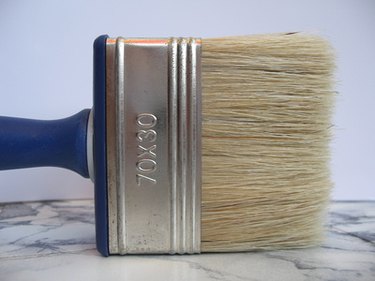
Solid wood, like fine wine, can get better with age under the right conditions. Ultraviolet radiation from sunlight and wind and rain are the enemy when it comes to keeping your wood looking the way it should. There are a number of different methods for sealing old wood. The least obtrusive are natural remedies such as linseed oil or paraffin wax. Spar varnish and latex paint can also be used depending on the desired effect.
Sealing to Preserve Looks
Video of the Day
Step 1
Clean the surface with a stiff nylon scrub brush to remove any dust and debris that might get trapped in the sealant causing an uneven finish. No sanding or stripping is needed to preserve the look of the wood as it is.
Video of the Day
Step 2
Apply a coat of linseed oil. Brush it on liberally with a soft bristle brush paying special attention to joints, gaps and cracks in the grain or between boards. For sealing purposes the heavier the better. Linseed oil naturally enhances the wood's ability to repel water, restores its natural moisture content and preserves the fibers.
Step 3
Top the linseed oil with paraffin wax, available in the paint department of home improvement centers . Rub the block of paraffin across the surface to leave a light coat. This can be buffed with a cloth to create a shine.
Step 4
Add a coat or two of spar varnish, if you don't mind the natural amber tint it will add. Brush the varnish on generously, working to avoid drips and runs which will harden into the finish.
Sealing for Structural Integrity
Step 1
Clean the wood thoroughly with a wire brush or power washer to remove dirt, debris and any loose finish that might flake off creating gaps in the sealer. Sand the wood and fill any voids with wood filler or auto body putty; allow to dry and sand smooth.
Step 2
Caulk around all edges, joints that don't move and hardware with a clear latex painter's caulk. Apply a coat of oil based primer. Roll it on with a paint roller or spread it with a disposable brush. Cover the entire surface and allow it to dry according to the label specifications before proceeding.
Step 3
Brush on two or three coats of semigloss exterior latex in your choice of colors. Allow adequate drying time between each coat and focus on avoiding runs and drips. Long straight strokes and a well loaded brush will give the most consistent results.